The Pope’s Climate Encyclical, Capitalism and the Environmental Movement
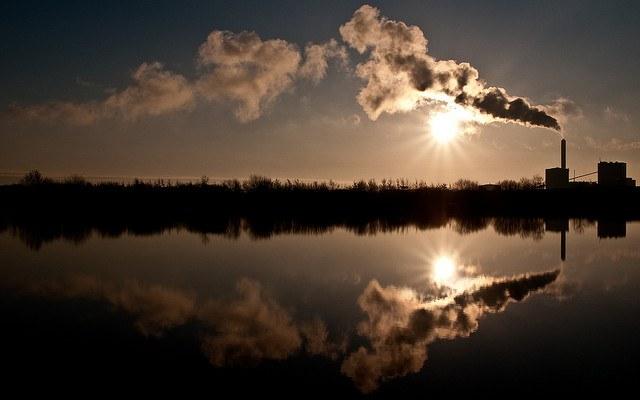

By Peter Fox-Penner
In 1987, film character Gordon Gekko stood before the shareholders of fictional Teldar Paper and instructed them that “greed is good.” This cinematic moment came to symbolize an era in which privatization, deregulation and financialization supplanted the mid-20th century model of progressive government, belief in a social safety net, and a mixed economy. Interestingly, the New York Times reports that the phrase was condensed from a graduation address at the University of California, Berkley business school given by Ivan Boesky, a Wall Street figure later convicted of insider trading.
It has taken 25 years to produce an equally cinematic moment to mark the end of this era. On May 24, Pope Francis issued what was widely reported to be an encyclical on climate change. Although climate change is discussed, the encyclical is more properly described as a sweeping critique of our market, technology and consumption-oriented society. His Holiness has produced a document that ranges from the current state of world political and economic policies to the health of global ecosystems, and what he calls:
"The social dimensions of global change ... [including] the effects of technological innovations on employment, social exclusion, an inequitable distribution and consumption of energy and other services, social breakdown, increased violence and a rise in new forms of social aggression, drug trafficking, growing drug use by young people, and the loss of identity."
His overall critique of our current economic and social disorder is searing:
" ... The economy accepts every advance in technology with a view to profit, without concern for its potentially negative impact on human beings. Finance overwhelms the real economy. The lessons of the global financial crisis have not been assimilated, and we are learning all too slowly the lessons of environmental deterioration."Some circles maintain that current economics and technology will solve all environmental problems, and argue, in popular and non-technical terms, that the problems of global hunger and poverty will be resolved simply by market growth. They are less concerned with certain economic theories which today scarcely anybody dares defend, than with their actual operation in the functioning of the economy.
"They may not affirm such theories with words, but nonetheless support them with their deeds by showing no interest in more balanced levels of production, a better distribution of wealth, concern for the environment and the rights of future generations. Their behavior shows that for them maximizing profits is enough. Yet by itself the market cannot guarantee integral human development and social inclusion."
Very few aspects of modern life left are unexamined in the document’s 80-odd pages. Some of the highlights include:
- A reminder that “nature is God’s art,” and that St. Francis of Assisi considered all creatures on earth his brothers and sisters;
- A warning against media and digital saturation: “ ... When media and the digital world become omnipresent, their influence can stop people from learning how to live wisely, to think deeply and to love generously ... True wisdom, as the fruit of self-examination, dialogue and generous encounter between persons, is not acquired by a mere accumulation of data which eventually leads to overload and confusion, a sort of mental pollution ... We should be concerned that, alongside the exciting possibilities offered by these media, a deep and melancholic dissatisfaction with interpersonal relations, or a harmful sense of isolation, can also arise.”
- A robust call for better global water policies: “ ... Our world has a grave social debt towards the poor who lack access to drinking water, because they are denied the right to a life consistent with their inalienable dignity. This debt can be paid partly by an increase in funding to provide clean water and sanitary services among the poor. But water continues to be wasted, not only in the developed world but also in developing countries which possess it in abundance.”
- Endorsement of an “ecological debt” between the global north and south and rejection of the “internationalization of the Amazon,” which “can only serve the economic interests of transnational corporations.”
- Urging that economies promote “diversity and creativity,” with particular emphasis on preserving small-scale agriculture;
- Acknowledgment that while “technology has remedied countless evils”, new breakthroughs such as GMOs should be examined closely for their ethical implications, and sometimes severely limited; and
- A strong scolding for global leaders’ response to environmental challenges. “It is remarkable how weak international policies responses have been … Consequently the most one can expect is superficial rhetoric, sporadic acts of philanthropy and perfunctory expressions of concern for the environment, whereas any genuine attempt by groups within society to introduce change is viewed as a nuisance based on romantic illusions or an obstacle to be circumvented.”
Climate change
As anticipated, the encyclical included a much-awaited Papal climate policy. There is a forceful description of the implications of “one of the principal challenges facing humanity in our day,” emphasizing impacts on the poor – loss of natural food resources, forced migration, and vulnerability to natural disasters. He then lays out a broad policy direction:
"There is an urgent need to develop policies so that, in the next few years, the emission of carbon dioxide and other highly polluting gases can be drastically reduced, for example, substituting for fossil fuels and developing sources of renewable energy. Worldwide there is minimal access to clean and renewable energy. There is still a need to develop adequate storage technologies."Some countries have made considerable progress, although it is far from constituting a significant proportion. Investments have also been made in means of production and transportation which consume less energy and require fewer raw materials, as well as in methods of construction and renovating buildings which improve their energy efficiency. But these good practices are still far from widespread.”
The ideas in this passage echo the advice of many climate policy experts and can be found in many national and subnational climate plans. However, the passage is noteworthy in several respects. First, it is less specific and lengthy than it could have been, and does not mention the importance of reaching a global agreement in the coming Paris climate summit. His Holiness clearly wants a climate solution, but he wants it grounded in broader economic and social change. Merely swapping high-carbon for no-carbon hardware -- a solution climate geeks used to call the “tech fix” – is flatly rejected.
It is good to see that His Holiness and his researchers have absorbed the verdant literature on the potential for greater energy efficiency and saw fit to give this often-invisible approach a Papal shout-out. Renewable energy, also mentioned, clearly plays a central role, although His Holiness notes that it is too inaccessible by much of the world’s poor. Interestingly, the encyclical neither includes nor excludes nuclear energy, apparently leaving that option on the table.
Above all, two very large and very important themes emerge from this masterwork. First, His Holiness forcefully rejects the notion of humanity’s right to shape the earth as it chooses for its private enjoyment. Rejecting the oft-cited interpretation of Genesis 1:28 that God granted man dominion over earth, he writes:
“We are not God. The earth was here before us and it has been given to us. This allows us to respond to the charge that Judaeo-Christian thinking, on the basis of the Genesis account which grants man “dominion” over the earth (cf. Gen 1:28), has encouraged the unbridled exploitation of nature by painting him as domineering and destructive by nature.”
His answer could not be clearer:
"This is not a correct interpretation of the Bible as understood by the Church. Although it is true that we Christians have at times incorrectly interpreted the Scriptures, nowadays we must forcefully reject the notion that our being created in God’s image and given dominion over the earth justifies absolute domination over other creatures."The biblical texts are to be read in their context, with an appropriate hermeneutic, recognizing that they tell us to “till and keep” the garden of the world (cf. Gen 2:15). 'Tilling' refers to cultivating, ploughing or working, while 'keeping' means caring, protecting, overseeing and preserving. This implies a relationship of mutual responsibility between human beings and nature."
He likewise rejects the notion of purely private property rights. Although private ownership of land is permitted, it is something of a fiction, as the ultimate “owner” of the earth is God. Our notion of ownership is apparently allowed, but only with recognition that its benefits be shared with the broader community:
"The Christian tradition has never recognized the right to private property as absolute or inviolable, and has stressed the social purpose of all forms of private property. Saint John Paul II forcefully reaffirmed this teaching, stating that 'God gave the earth to the whole human race for the sustenance of all its members, without excluding or favoring anyone.'
These are strong words. He noted that "a type of development which did not respect and promote human rights – personal and social, economic and political, including the rights of nations and of peoples – would not be really worthy of man."
It is important to see this not as a complete rejection of property and markets, but rather as a severe admonition that these institutions must be rigorously tempered by a purpose beyond pure private gain. Again, quoting Pope John Paul II, Francis writes:
"He clearly explained that ‘The Church does indeed defend the legitimate right to private property, but she also teaches no less clearly that there is always a social mortgage on all private property, in order that goods may serve the general purpose that God gave them.'"
In the end, one forceful and persistent theme permeates the encyclical: the indivisibility of social and environmental problems. His Holiness states:
“We are faced not with two separate crises, one environmental and the other social, but rather with one complex crisis which is both social and environmental. Strategies for a solution demand an integrated approach to combating poverty, restoring dignity to the excluded, and at the same time protecting nature.”
Indeed, to my eyes the Pope reserves his strongest language for global elites, who have paid too little attention to the deep connections between global inequality and environmental problems:
"The impact of present imbalances is also seen in the premature death of many of the poor, in conflicts sparked by the shortage of resources, and in any number of other problems which are insufficiently represented on global agendas ... This is due partly to the fact that many professionals, opinion makers, communications media and centers of power, being located in affluent urban areas, are far removed from the poor, with little direct contact with their problems. They live and reason from the comfortable position of a high level of development and a quality of life well beyond the reach of the majority of the world’s population."
Francis’ argument that all those who care about the environment must work just as hard to care for the less fortunate comes along at an interesting time for the American environmental movement and the American left in general. With a deeply divided Congress and equally polarized country, the movement has recognized that greater environmental progress through federal legislation will be nearly impossible for some time. This would be an excellent time to continue building a coalition in the vision of the Pope, joining economic and environmental issues that share many common roots and drivers. This is hardly a new idea or effort – many individuals and groups have been working hard on this for years, even decades. What’s new is that the head of a highly respected Church central to the faith of over 1 billion people has unequivocally not just endorsed the view – he has said there is no other way.
And as for greed being good? Francis quotes Patriarch Bartholomew’s exhortation to consumption with sacrifice, greed with generosity, wastefulness with a spirit of sharing which “entails learning to give, and not simply to give up. It is a way of loving, of moving gradually away from what I want to what God’s world needs. It is liberation from fear, greed and compulsion."
Take that, Mr. Gekko.
Image credits: 1) Flickr/Javier 2) Flickr/Peter Rosbjerg
Peter Fox-Penner, principal and Director of The Brattle Group, specializes in economic, regulatory, and strategic issues in network industries. His book, "Smart Power: Climate Change, the Smart Grid, and the Future of Electric Utilities," examines innovative business models for the changing utility industry.
A Better Way of Doing Business


By Giles Hutchins
Much of today’s organizational management mindset (whether corporate, nonprofit, government institution or startup) is rooted in a flawed logic about how the world works.
"We have been, and still are, in the grips of a flawed view of reality – a flawed paradigm, a flawed worldview – and it pervades our culture putting us on a biological collision course with collapse," said Ray Anderson, once voted America’s most admired CEO.
Central to this flawed logic is a control-based, oppositional-mindset with a tendency to polarize and reduce life’s tensions into separations: organism separate from environment; God separate from Creation; us separate from them; yin separate from yang; mind separate from matter; rational analytical thought separate from embodied and intuitive ways of knowing.
"We have created a sufficiently strong propensity not only to make divisions in knowledge where there are none in Nature, and then to impose the divisions on Nature, making the reality thus comfortable to the idea, but to go further, and to convert the generalizations made from observation into positive entities, permitting for the future these artificial creations to tyrannize over the understanding," said British psychiatrist Henry Maudsley.
This ‘logic of separation’ has profound implications for Western philosophic and socio-economic systems culminating in the ‘mind-divorced-from-matter’ materialism of the Age of Reason still pervading our worldview today. The origins of Western philosophy, however, drew from a deeper wisdom that transcended this ‘logic of separation’ – for instance, Pythagoras, Parmenides and Plato sought to attune with the ‘wisdom of Sophia’ permeating throughout Nature, a gnosis of life’s tensions transcending the shallow ego-mind’s reductive tendency to polarize and separate.
And yet, over time, due to various contributing factors, our culture has become mired in this ‘logic of separation.' Our ways of knowing and attending to life have been acculturated at deep and partly unconscious levels, infecting how we relate with our own sense of self, each other and the world around us.
By example, there is a deeply held philosophical believe amongst the well-educated in the West that decision-making ought to be separated from the undertaking of the work itself: strategic thinking and layers of management-control are separate from labour, and labour itself is separated and reduced into departmental ‘economies of scale’ for normalization, management and control. This separation is espoused by the scientific management thinking of Taylorism, industrial and post-industrial productization, and the quantification-obsessed ethos of management-by-numbers. It is a reductionist, mechanistic logic: hallmarks of the Age of Reason.
Today we find all too many organizations caught up in a top-down, hierarchic, KPI-obsessed, silo’ed, control-based mentality. While it is assumed that such an approach to work enhances efficiencies and effectiveness, the reality is that it undermines and erodes the greatness of our workplaces, turning them into places of drudgery, stress, political infighting and ineffective bureaucracies.
Instead of focusing on our sense of purpose and quality of value-creation for stakeholders hand-in-hand with the undertaking of enjoyable enriching productive work, attention is taken-up with ‘people management,' ‘activity management,' ‘production management,' ‘budget control' -- techniques aimed at managing units and numbers. The inter-relational, holistic and humane spirit of work is reduced into little more than reporting line items.
As organizational specialist John Seddon notes:
"Command-and-control management has created service organizations that are full of waste, offer poor service, depress the morale of those who work in them and are beset with management functions that not only do not contribute to improving the work, but actually make it worse. The management principles that have guided the development of these organizations are logical – but it’s the wrong logic."
Systems scientist Peter Senge notes that the biggest challenge facing leaders and managers today is this transformation from linear, mechanistic, control-based logic to systemic, organic, emergent, embodied ways of operating and organizing where the organization is understood as a flourishing living being rather than a mechanistic machine.
The good news is, we are on the cusp of a radical sea-change in how we perceive our ways of operating and organizing:
Firm of the Past Firm of the Future
Economies of scale Economies of flow
Linear thinking Systemic thinking & being
Silo’ed units of production Systems of inter-relations
Measurement-focused Purpose-focused
Dominator-model Partnership-model
Machine-mentality Living organization
"The organisation of the future will be an embodiment of community based on shared purpose calling on the higher aspirations of people," said Dee Hock, founder of VISA.
Attempting to transform our ways of operating and organizing toward humane, sustainable businesses without addressing this flawed mindset is like applying the preverbal Band-Aid to a systemic illness. Isolated initiatives such as ‘wellbeing at work,' ‘mindfulness in the workplace,' ‘talent management,' ‘open innovation,' ‘closed loop economics’ or ‘corporate responsibility’ are useful in themselves and can have knock-on catalytic affects. Yet if they leave the underlying culture and ethos of the organization unchecked, they ultimately fail to deliver transformative change towards flourishing, resilient firms of the future.
We need to deal with root causes as well as the detrimental downstream effects this logic creates: unsustainable operations, mental health issues, lack of moral, low levels of creativity and performance, inflexibility in times of volatility, etc.
Firm of the Past Firm of the Future
Top-down hierarchy Locally-attuned
Control ethos Learning ethos
Remote management by numbers Distributed decision-making
Bureaucratic Participatory, self-organizing
Short-term shareholder profit Value-creation for stakeholders
Competition-orientated Collaboration and co-creativity
Private ownership and control Open-source, open-innovation
Self-preservation/maximization In service of something greater
Exploitation and enslavement Empathy and empowerment
To change management thinking one cannot just change the roles and measures (although that helps). To truly change our ways of organizing and operating we need to change our philosophy, our ways of thinking and knowing, our perception of how the world works and our sense of place and purpose within this deeply wise world. No small feat.
Let’s take a moment to ask ourselves these questions:
- Why are we here doing what we are doing?
- What are we in business for – what is the real underlying purpose?
- What value are we delivering to society? What about to the wider fabric of life?
- Do we wish our activities to help or hinder life?
- What do we deeply love doing?
- How can our work resonate more strongly with this love and a deeper sense of purpose?
There are many examples of organizations varying in size and sector who are actively challenging yesterday’s logic while exploring new ways of operating and organizing: Semco, Sounds True, Natura, Patagonia, Weleda and Interface, to name a few.
There is a metamorphosis in our midst. As with the metamorphosis of a caterpillar to a butterfly, the initial stages of transformation are resisted by the incumbent dominant paradigm, yet, as more ‘imaginal cells’ of the ‘new way’ form into clusters, a tipping point is reached where wider understanding and acceptance of these transformative ways operating and organizing systemically form.
We live in a volatile time of great potential. The question is: Do we wish to be a part of the emerging future or hold-on fearfully to old ways of working? Time to transform: It’s a time to let go of old ways and allow the new to emerge; it's a time to lead with courage beyond fear.
To explore ‘the new paradigm’ further, join the Facebook community here.
Image credit: Flickr/Terrapin Flyer
Giles Hutchins is author of The Illusion of Separation book on Amazon and on Amazon.com and The Nature of Business on Amazon and on Amazon.com he blogs at www.thenatureofbusiness.org
4 Ways to Tell If a Company Is Really 'Green'
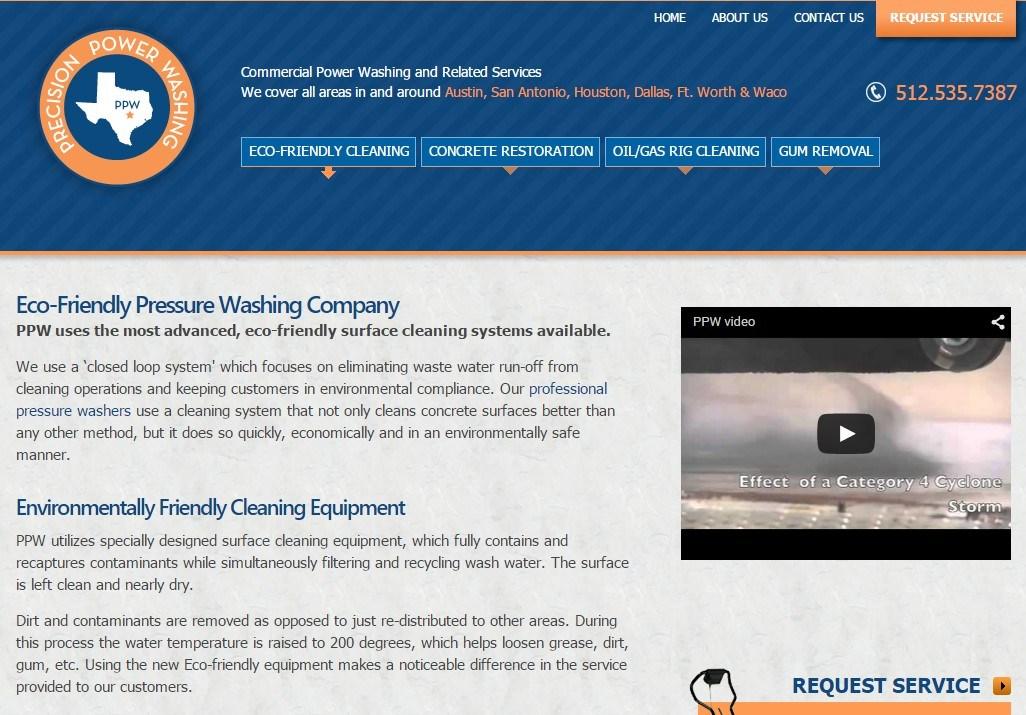

By Scott Huntington
Walk down the aisle of any grocery store, and it’ll be easy to see that there’s a growing trend toward eco-friendly practices and products. Then look online and you’ll see the same thing. NBC had a whole “green week,” Adidas created a new shoe made from ocean waste, and even Ford is touting an EcoBoost engine and products. But, how can you tell if a company is truly committed to environmental sustainability, or if it's just trying to cash in on the ever-growing eco-friendly market? Read on to find out.
1. Look for very specific claims
If you’re feeling a little overwhelmed shopping for products that are kind to the Earth, take a closer look at the label and the website. Speaking generally, the more specific the wording, the more likely it is to be genuine.
For example, something that says “all-natural” or “eco-friendly” doesn’t carry as much weight as a label that reads, “Made with 100 percent natural, organic and fair-trade ingredients” or, “Manufactured at a plant that has an ongoing plan to reduce carbon emissions.”
Precision Power Washing of Texas does this particularly well (see below). It calls many of its services “eco-friendly,” but so does everyone else. What sets the company apart is that it has a whole section of its website devoted to detailed information of how its service helps the environment.
2. Check for commitment
When in doubt about the eco-friendliness of a company, don’t be afraid to do some research to see how long the company has done good things for the environment. Also, if you’re just looking for some direction in regards to which companies are most committed to the Earth, there are some useful articles to peruse.
Keep in mind, even if you discover a company has “gone green” only recently, that doesn’t necessarily mean it has less-than-pure intentions. Sometimes companies are best equipped to strive toward environmentally-friendly practices only after the technology has been put in place to make it possible.
3. Ask within your personal conversations
There’s no harm in making a good effort toward buying major brands that profess both an awareness of sustainability and the willingness to do something positive about it. However, you can also do your part to support smaller businesses that are within your community.
When deciding to lend your patronage to a particular establishment, experiment with different ways to incorporate environment-related questions into your chats.
To help you determine a company’s intention, simply say, “Has your business done anything specific to combat climate change? This is a very important issue for me.” If a manager meets your answer with a blank stare or dismissive response, that kind of feedback may be your cue to look elsewhere when you need a service provider or product.
4. Study the packaging
Some companies might choose to sell eco-friendly products that feature bright, beautiful labels with pictures of trees and a recycling symbol, but those products are packaged in containers that aren’t even constructed with recycled materials. If a product’s package is made entirely or partially from recycled materials, that’s a sign that the company is trying to take an all-encompassing approach in making a meaningful difference.
In 2012, Starbucks Coffee launched cup sleeves that resulted in saving approximately 100,000 trees annually. Measures like that demonstrate the company doesn’t just talk about a desire to be kind to the Earth, but it actually uses products that support the intention.
--
Hopefully, you now feel more confident that you’ll be able to maintain your priority of being kind to the environment when you shop. However, keep in mind that being a proactive consumer is a process. Although you may make some mistakes along the way, even being motivated to support companies that have green mindsets is a very important step in the right direction. It’ll minimize the size of your personal carbon footprint, too.
Image credits: WikiCommons | SpoolTuning | PPWTX | Starbucks
Scott Huntington is a writer and blogger. Follow him on Twitter @SMHuntington
Pirelli revs up sustainability rating


Pirelli has been named as the leading automotive supplier in an assessment for the Frankfurt Stock Exchange.
Based on the DVFA's (Deutscher Verband der Finanzanalysten) published standard ‘KPIs for ESG 3.0’, the study awarded points up to a maximum of 100. Pirelli received 99.60 points in the Environmental Sustainability category, 99.0 points in the Social category and 97.80 points in the Corporate Governance category. No other company in the same sector obtained comparable top values.
The analysis was based on approximately 100 ESG indicators, covering the fields of the environment, social responsibility and governance and carried out by Sustainalytics.
Sustainalytics used a variety of sources such as corporate communications, corporate websites, media reports, information from NGOs (non-government organisations), government agencies and direct dialogue with the business itself, in order to assess the sustainability of the company's activities.
The Frankfurt Stock Exchange regularly publishes sustainability indicators to provide investors with the opportunity to support responsible company management.
Coming Soon: The End of Coal
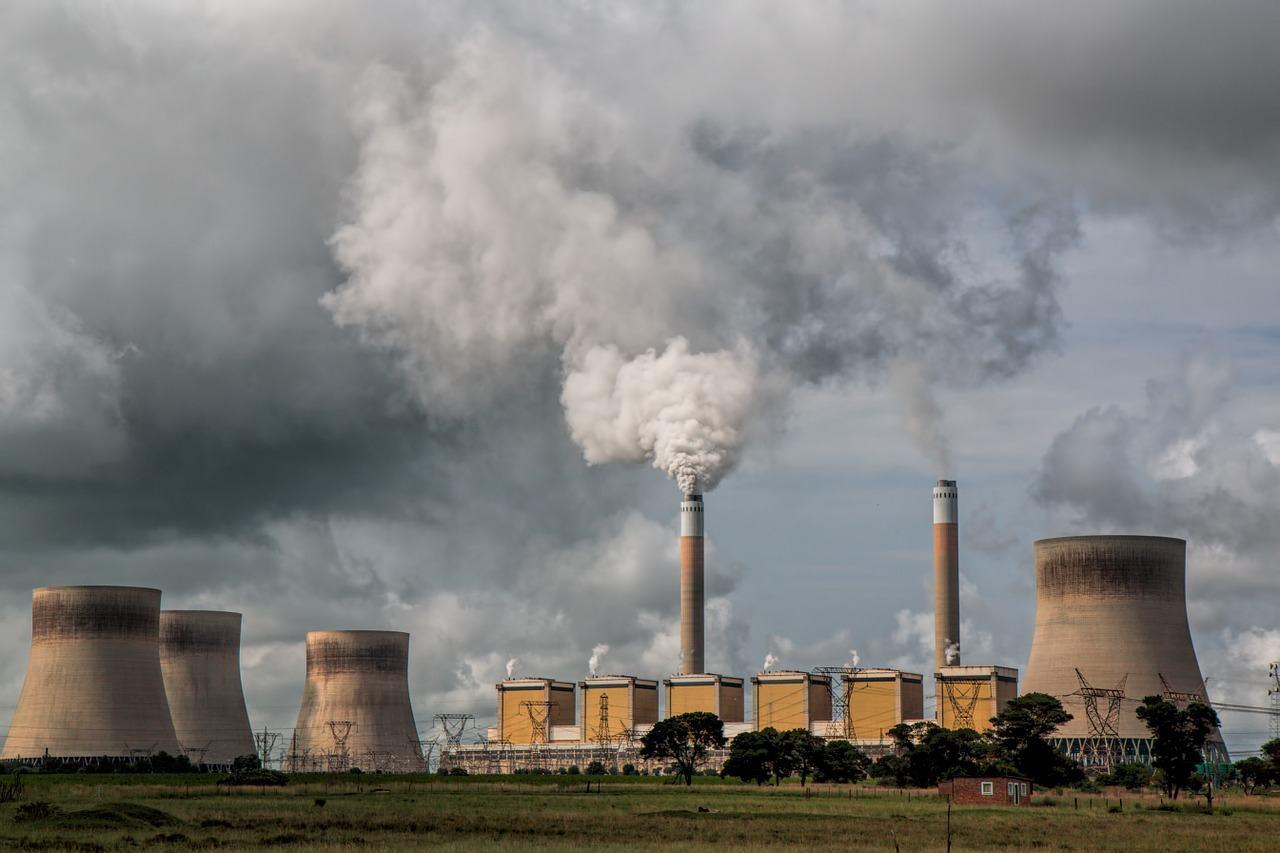

Thanks to a concerted campaign by environmentalists and huge progress in renewables, coal is (finally) on the way out.
One of the first campaigns I worked on was the Sierra Club's ambitious Beyond Coal Campaign. Our goals was simple – organize grassroots efforts across the country in opposition of then-President George W. Bush's push to expand coal power generating capacity across the United States.
Here's the amazing thing. The campaign was successful – in fact, beyond successful. We haven't had a new coal power plant open in the United States since the campaign launched more than seven years ago. America is, amazingly, moving beyond the dirty energy that defined its growth as an industrial nation, and a recent report from Bloomberg shows that the coal industry is facing financial turmoils unlike any its in history.
It's not just America, the effects of the coal bust are being felt globally. China, once a prime culprit with its one-coal-plant-per-week opening rate, is nearing peak coal years ahead of schedule. It has dramatically cut its coal imports, leaving those China-focused coal shipping terminals planned for the West Coast without a market to export to.
India, widely expected to become the next China, is showing signs that it might leapfrog dirty energy and go straight to clean energy as renewable investments boom.
All this is what is causing the tumbling of coal prices, which, honestly, caused some fears. It was easy to push against coal when energy prices were high. But if coal was cheap, that would make it harder for renewables to compete, and perhaps make dirty energy more feasible, at least in the short term.
Turns out, it doesn't matter -- most clearly demonstrated by coal bonds.
Coal prices have crashed, sure, but for a real sense of coal's diminishing prospects, check out what's happening in the bond market.
"Bonds are where coal companies turn to raise money for such things as new mines and environmental cleanups. But investors are increasingly reluctant to lend to them. Coal bond prices tumbled 17 percent in the second quarter, according to an analysis by Bloomberg Intelligence. It's the fourth consecutive quarter of price declines and the worst performance of any industry group by a long shot," Bloomberg staffer Tom Randall wrote last week."A 17 percent decline is huge, and it happened at a time when other energy bonds — oil and gas — were rising. Three of America's biggest coal producers had the worst-performing bonds for the quarter."
We still have a long way to go, as dirty fossil fuels still account for most of the world's energy production. That is one reason that Sierra Club has shifted from targeting proposed coal plants to fighting to get old, dirty plants closed. And so far, the organization is seeing the same success.
The international effort is growing, too. Last year I attended a no-coal meeting in Indonesia, the country which, last year, exported more coal than anyone else in the world. We looked at strategies to fight proposed coal plans in the Philippines, Vietnam, India, Japan and South Korea, most of which would be powered by Indonesian coal.
The markets may have just given a boost to this campaign. Judging by how badly energy stocks and bonds are performing (and how good clean-energy companies like Tesla are in comparison), it may be too risky for anyone, anywhere, to invest in coal. And that's just the way we like it.
Image credit: Pixabay
How the U.S. Stacks Up In Terms of Ecological Footprint and Resource Availability
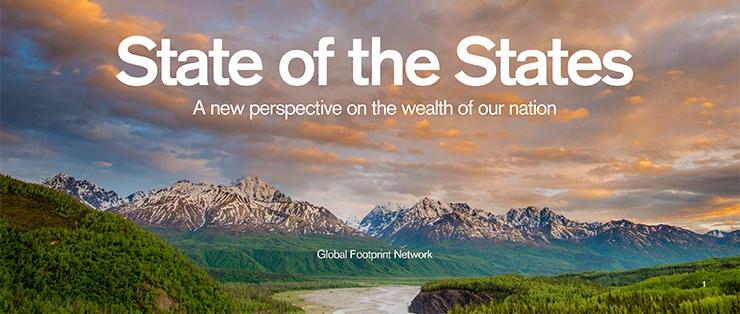

Have you ever wondered how the U.S. and its states are doing in terms of resource availability and ecological footprints? You don’t have to wonder any longer. A report by Global Footprint Network and Earth Economics, titled State of the States: A New Perspective on the Wealth of Our Nation, details the ecological footprint and resource availability of the 50 states and the District of Columbia. What the report finds is that resource consumption and availability are dramatically different from state to state.
When it comes to the U.S. in general, what the report finds is not pretty. The U.S. population is using twice the renewable natural resources and services that can be regenerated within the country. The third-richest country in the world in terms of biocapacity, with Brazil and China in the top two spots, the U.S. has the second-largest share of the world’s overall ecological footprint, behind China, which has a population four times that of the U.S. The total footprint of the U.S. is almost twice that of India, a country with a population almost four times that of the U.S. The per-person ecological footprint in the U.S is more than twice China’s and more than seven times India’s. Only 16 states in the country are living within the means of their natural resources.
What about the findings regarding specific states? Here are some highlights:
- States with the largest per-person ecological footprints are Virginia, Maryland and Delaware.
- States with the smallest per-person ecological footprints are New York, Idaho and Arkansas.
- The most resource-abundant states based on biocapacity are Alaska, Texas and Michigan.
- The states with the least biocapacity are Rhode Island, Delaware and Arizona.
- California, Texas and Florida have the highest ecological deficits.
- Alaska, South Dakota and Montana have the greatest ecological reserves.
Renewable energy use will play a larger role in the future
Renewable energy use is a major way that states and the nation can lower their ecological footprints. California became the first state to generate over 5 percent of its electricity from utility-scale renewables earlier this year, but six states are farther ahead than the Golden State in overall renewable energy dependence. The majority of the renewable energy in those six states comes from hydropower, which the report points out is “well-exploited and very geographically specific.”
However, the report finds that the U.S. is “clearly preparing for a future in which sustainable energy plays a much larger role, and most states still have substantial opportunity to tap into solar and wind energy to reduce the carbon intensity of their economies.” Now, that is good news for the U.S. and its citizens.
California: A state with the biggest ecological footprint but some of the highest environmental standards
California is the seventh-largest economy in the world. It has the largest population in the U.S. and a huge ecological footprint to match. It would take eight Californias to support Californians’ ecological footprint as they are using more than eight times the state’s available biocapacity. The four-year historic drought threatens to further decrease California’s biocapacity.
California’s carbon footprint is the largest percent of its ecological footprint, but the average Californian’s carbon footprint is lower than that of the average American. The report attributes it in part to a mild climate that needs less heating and cooling, but also to energy efficiency measures, hydropower use and less coal use than other states. California also has its own gasoline standards, a cap-and-trade system to reduce greenhouse gas emissions, and a renewable energy standard of obtaining 33 percent of electricity from renewable energy by 2020.
Image credit: Global Footprint Network
Make That Two Black Eyes For Natural Gas Fracking
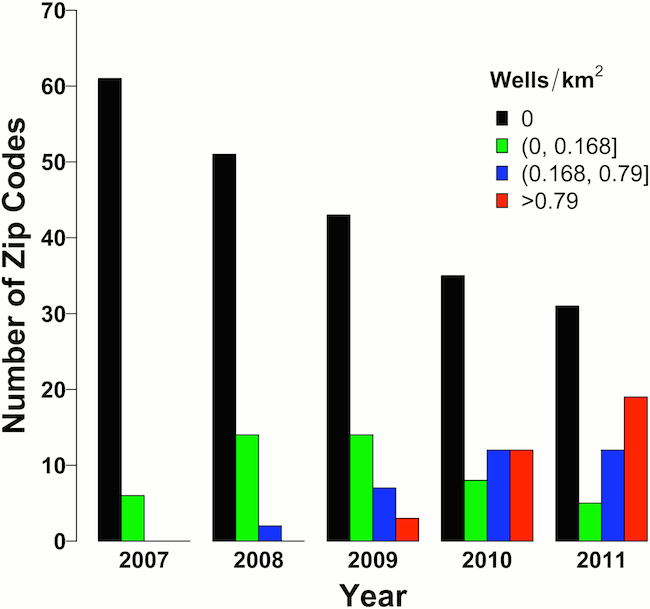

Fleet owners in the U.S. have been turning to compressed natural gas as a "clean" alternative to diesel and gasoline, but a new study of natural gas fracking in Pennsylvania suggests that there are deep holes in the strategy.
The new study, from the University of Pennsylvania and Columbia University, links a significant increase in hospitalizations to a "meteoric" increase in the number and density of natural gas wells in two Pennsylvania counties.
The new natural gas fracking study
Fracking refers to a formerly unconventional gas and oil drilling method [UGOD] that involves pumping vast quantities of chemical brine deep underground. Fracking -- short for hydrofracturing -- was practiced for many years in the U.S. without attracting any scrutiny, primarily because it was confined mainly to thinly populated areas in the West. Now that frackable formations in the more heavily populated Midwest and Northeast states are being exploited, significant problems are beginning to emerge.The latest fracking study looked at three northeastern Pennsylvania counties with comparable demographics. Bradford and Susquehanna counties experienced an increase in fracking activity during the study period, from 2007 to 2011. The third, Wayne County, had no new wells during the study period and was used as a control model.
The study looked at 198,000 hospitalizations by zip code, from 2007 to 2011. The in-patient stays were categorized by cost, and the top 25 categories were selected for analysis.
The findings (break added):
" ... revealed that cardiology and neurologic inpatient prevalence rates (the proportion of a population found to have been hospitalized per 100 residents per year) were significantly higher in areas closer to active wells, as determined by the proximity of wells to a person’s home and their density as defined by the number of active wells per square kilometer."In addition, increased neurologic inpatient prevalence rates were associated with higher well density. Hospitalizations for skin conditions, cancer, and urologic problems were also associated with the proximity of dwellings to active wells."
While cautioning that a causal connection is yet to be determined, the researchers are particularly struck by how quickly the correlation between fracking and hospitalizations emerged:
" ... While the clinical significance of the association remains to be shown, UGOD has just begun in Pennsylvania, and thus observing a significant association over this short time is remarkable."
To be clear, a direct causal link between fracking and health impacts is difficult to pin down, primarily because of wide information gaps enabled by a Bush-era regulatory loophole. However, the study does indicate that the economic benefits of fracking activity should be weighed against the potential for significant public health consequences, including an increase in health care costs:
"Our study also supports the concept that health care utilization should be factored into the value (costs and benefits) of hydraulic fracturing over time."
Still not the last straw for fracking
Earlier this month, TriplePundit reviewed three other new natural gas fracking studies that revealed significant water resource issues, public health and community character impacts, and negative effects on other economic sectors, namely agriculture.
This fourth study is certainly not the last straw for natural gas fracking, but scores of local communities have already banned the practice, and just this summer, New York state and Maryland transitioned from moratorium to permanent ban.
In that regard, it is notable that the third county in the Pennsylvania study, Wayne, had no new wells during the study period because of a moratorium imposed by the Delaware River Basin Commission, due to potential impacts on the Delaware watershed.
The legislative response indicates that awareness of the potential for negative impacts is growing, and the increase in hospital visits indicates that part of this trend is linked to direct exposure rather than a general environmental concern or hearsay.
In that context, it is notable that the new fracking study covered only in-patient hospital stays. If there is also a corresponding increase in visits to doctors' offices, walk-in clinics and urgent care facilities, the level of concern related to direct exposure will increase accordingly.
The road to a truly green fleet
That brings the conversation back around to green fleets. Compressed natural gas (CNG) is becoming a fuel of choice for converting fleets to cleaner fuels, particularly when it comes to diesel.
However, with evidence of negative impacts mounting, fleet managers are best advised to explore alternatives including electric vehicles, biogas, liquid biofuel or fuel cells powered by renewable biogas.
Image credit: Via PLOS ONE, creative commons license.
ExxonMobil Still Oils the Palms of Climate Science Deniers


This is probably no surprise, but word that ExxonMobil is still funding climate science deniers also reveals how feckless and arrogant the company is.
Actually that’s no surprise either. It’s like if you complain long enough and loud enough, or nuance the “debate” enough — with unlimited funds backing you up — it somehow can make a wrong conclusion look right, deflect it, or at least drown out the opposition.
A long piece this month in the Huffington Post by Elliott Negin, a senior writer at the Union of Concerned Scientists, outlined ExxonMobil’s current approach on climate change and also cited this carefully parsed statement from spokesman Richard Keil: “We do not fund or support those who deny the reality of climate change."
That sounds good as far as it goes, because as the HuffPost article notes: “Practically no one can say with a straight face that global warming isn't happening anymore. Most, if not all, of the people who used to deny the reality of climate change have morphed into climate science deniers.”
Climate science deniers concede that climate change is occurring but question or reject the idea that human activity, mainly burning fossil fuels, is behind it. “Likewise, they understate the potential consequences, contend that we can easily adapt to them, and fight government efforts to curb carbon emissions and promote renewable energy,” Negin continues.
And ExxonMobil is funding those people. Here’s what Negin found: “According to the most recent publicly available data, last year ExxonMobil spent $659,000 on congressional climate-science-denier political campaigns and $1.9 million on 15 denier think-tanks, advocacy groups and trade associations for a total of $2.56 million. Meanwhile, between 2007 and 2014, the company spent at least $10 million on climate science denier organizations to spread disinformation and undermine efforts to address climate change.” The company spent nearly $21 million from 1998 through 2006 to fund denier groups.
While the funding of 40-plus denier groups in 2007 has decreased to about 15, organizations such as the American Enterprise Institute, American Legislative Exchange Council and Manhattan Institute for Policy Research “are still doing their best to sow doubt about climate science and denigrate renewable energy.”
It makes for fascinating reading, including Negin’s response to Keil’s statement that ExxonMobil believes “the risk of climate change is clear, and warrants action.” Negin wrote:
“A close reading of the transcript of the company's annual shareholders meeting in May says otherwise. Over the last 25 years, ExxonMobil has repeatedly fended off shareholder resolutions to address climate change, and this year was no different. The message was loud and clear: Stay the course. Technological ingenuity will enable us to cope with the consequences.“One shareholder-sponsored resolution called on the company to set goals for curbing carbon emissions. Another would have required the company to appoint a climate change expert to its board. Still another requested a report on the company's state and federal lobbying expenditures, including lobbying through trade associations and other organizations, such as ALEC. The answer was no, no and no. None of the climate-related resolutions passed.
“In his opening statement at the meeting, CEO Rex Tillerson predicted that oil and natural gas 'will meet about 60 percent of global energy in the year 2040.' And when asked later why he uttered nary a word about renewable energy in his remarks, Tillerson quipped, 'We choose not to lose money on purpose' to loud applause.”
The message: Full steam ahead on maximizing quarterly profits no matter the consequences of climate change. Also full steam ahead on the disinformation campaign: We should be long past the time when the oil majors think they can turn the evidence about climate change around. ExxonMobil’s stubborn activity is intellectually dishonest and ethically criminal.
Image: Exxon by Mike Mozart via Flickr CC
Why Isn’t That Recruiter Getting Me a Job?


By Shannon Houde
Sorry for the disappointing news but recruiters work for companies, not candidates. Think about it. Who is paying them? What's more, they don’t usually have time to do the market research and networking for each individual candidate to help them “get a job." It doesn't matter that you are a lovely person with a marketable skill-set; if you don’t fit the exact requirements for their current openings, recruiters may not be very responsive.
Don’t take it too personally! This is the way the recruitment industry works. If you want to land your dream sustainability job, you need to understand these mechanisms to make the recruitment process work for you rather than against you.
With that in mind, here are some top tips for working with a recruiter to improve your chances for success at each stage of the recruitment process:
Stage 1: Selecting the right recruiter
- Go through recommendations. Speak to others who have a similar professional background to yours, ask which recruiters they have used and - more specifically - which individual within the recruitment company they have worked with.
- Be strategic about who represents you. Work with one or two recruiters who best represent your interests in the sector in which you want to work. If you are working with multiple agencies it can become confusing knowing exactly what you have applied for and who exactly is representing you. Recruiters will be more motivated it you commit to working with them exclusively.
- Before you approach a recruiter, consider seriously whether you would accept a counter offer in your current role. If the answer is yes, think about negotiating your package with your employer prior to searching for a new job. If you turn down an offer that a recruiter has brokered to remain in your current position, you should expect that they may be frustrated. Often they are working on a 'fee on success only basis', so they may not be so helpful next time you need their assistance. It is a two-way street, and you will get more out of them if you develop a firm and open relationship.
- If possible, meet face to face with the recruiters you are working with. This helps you to form a much closer relationship with your recruiter and shows a real commitment to the process.
Stage 2: Building a strong relationship with your recruiter
- Give them the essential information the first time you meet with them and be transparent. If they are good recruiters they will want to gather a lot of information about you in order to best represent you to future employers. They will want to know details of your full benefits package, realistic location requirements, reasons for being on the market, etc. You need to be willing to spend some time on the phone with them as well as meeting face to face. Be open. Don't take offence if they ask you to amend your CV. They know best what their clients want and their own personal success is based on making a successful match between you and an employer.
- Don't be forced into interviews or paths that you do not wish to investigate. Set the goal posts at the start of the relationship and make your requirements and desires clear. If you are working with a good recruiter they may push back and advise you to look at other options. Remember that they are the experts and their advice is worth listening to so be flexible but don't waste your time, the recruiter's time or an employer's time by attending dead-end interviews. However, remember that some interviews are worth attending even if you are quite sure the opportunity is not right. A couple of hours invested in meeting an employer may come back to benefit you in the future.
Stage 3: Communicating with your recruiter
- Keep in contact with the recruiter, but not too often. A fortnightly or monthly call is fine but they are likely to be in touch with you should they have suggestions. Keep them informed of any circumstance changes (pay rises, change of location preferences, reduction in urgency of your job search, etc.).
- Return your recruiters’ calls promptly. Recruiters want to work with responsive candidates and if calls aren't returned it gives off bad signs. Conversely, if a recruiter doesn't return your calls over a period of time, consider whether they are the best suited to represent you.
- Be open with recruiters with whom you are working. If you are attending interviews with a number of organizations let them know that is the case. The more open and honest you are about your employment search the more likely the recruiter will be open with you in respect to your suitability for specific roles and candid with their feedback.
I hope this helps you develop a more fruitful relationship with your recruiter. If you'd like some one-on-one advice on developing your personal brand to sell your skills in the jobs market, get in touch today.
Image credit: Flickr/David Goehring
Shannon Houde is founder of Walk of Life Consulting, the first international career and executive coaching business focused solely on the environmental, sustainability and corporate responsibility fields.
What America Can Learn From the California Water Crisis


By Scott Huntington
It has been four years since California first slipped into the drought that’s now causing panic among the state’s citizens and government. Ninety-three percent of Californians have been affected by the lack of water. The greatest cause of panic, though, is that it doesn’t look like this drought will end any time soon.
Researchers head up to the Sierra Nevada mountains each year to analyze the snowpack and predict just how much precipitation will fall in the next year. They found 40 percent less snowpack on the mountains this year than they did last year. This news is particularly bad, considering snowpack can predict about 70 percent of precipitation that will happen in the future. Californians, therefore, can count on even less rain next year than in the last, and last year’s measurements were already very low.
Since Mother Nature doesn’t seem keen to repair the drought on its own, the state of California has had to enact a slew of regulations in order to keep its water supply as robust as humanly possible. As it fights against perhaps one of the worst dry spells in 1,000 years, California teaches the rest of the country many vital lessons when it comes to dealing with and reversing the effects of a drought; below you’ll find three of them.
1. Prepare for big fluctuations in water
There doesn’t seem to be a middle ground in California. The state either has plenty of water from rain and snowfall, or it’s in a state of drought. In fact, the water supply ebbs and flows by up to 40 million acre-feet, depending on the year.
In times of lesser drought, officials have simply shuttled water from the precipitation-heavy northern half of the state to the more heavily populated south. Unfortunately, their system isn’t standing up to the current shortage of water. And, to make matters worse, Mother Nature hasn’t added much by way of melting snow or falling rain.
Take note: The best preparation comes before disaster strikes. A more consistent water-saving plan and a better infrastructure for sending and sharing water statewide could have softened the blow.
2. Keep the wildlife in mind
Humans aren’t the only ones who need water. Your long shower or afternoon car-wash might mean your local stream or river is reduced to a trickle. These trickles can’t maintain any sort of ecosystem.
California has plenty of laws in place meant to keep these ecosystems thriving. It might cause some to scratch their heads — why should a fish be prioritized over me? — but it’s vital to the environment at large.
Other areas should follow suit by coming up with a similar plan of action, should main water supplies start to run low. It’s okay to dip into the pond, but you never want to drain it entirely.
3. Seek an unlikely culprit
You’ve heard tips like lathering up in the shower while the water’s off and brushing your teeth without opening the tap. Many residents are also going to professional pools or community pools instead of filling up their own. These are all great ideas and can be enacted in households everywhere; however, your domestic water usage doesn’t hold a candle to agricultural usage.
Surprisingly enough, California’s agricultural sector makes up a whopping 80 percent of the state’s water usage, while city usage counts for the remaining 20 percent. California is a huge food supplier to the rest of the country, but at what cost? It’s an interesting question for other states and areas to ask should they fall into a similar situation.
There’s no foolproof way to deal with a drought, and there’s no way to point fingers and say who is or isn’t to blame for California’s current state of crisis. If everyone takes time to be more mindful — government, farmers and citizens together — then perhaps other states can avoid the stress of a dwindling water supply that’s only going to shrink in the coming summer heat.
Image credits: 1) Flickr/Marufish 2) Flickr/Tim J Keegan 3) Flickr/Armin Vogel
Scott Huntington is a writer and blogger. Follow him on Twitter @SMHuntington.